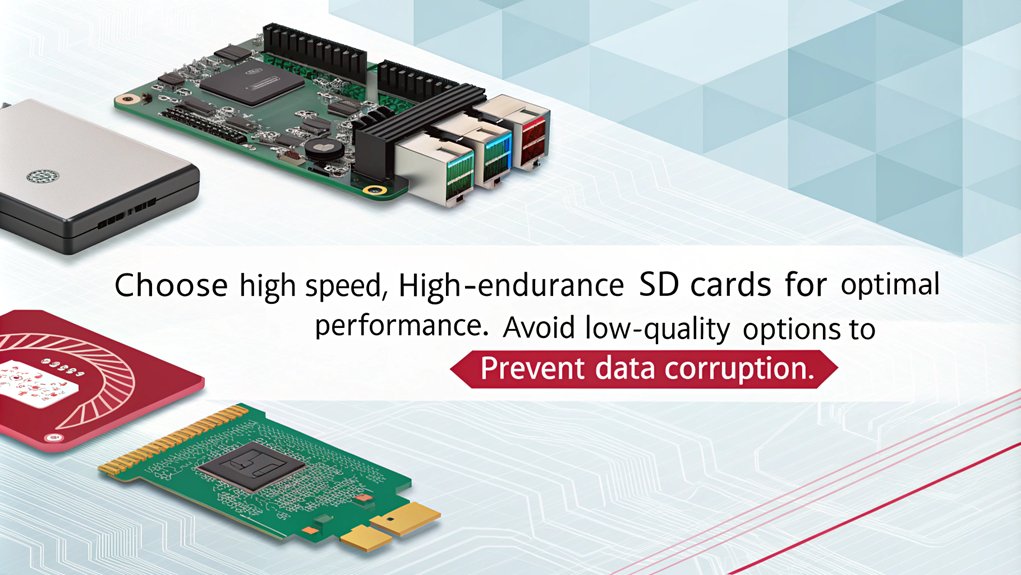For best performance with your Raspberry Pi 4, you should opt for SD cards that prioritize speed and reliability. Look for cards like the Samsung Evo+ or SanDisk Ultra for a budget-friendly choice. Ideally, choose cards with speed classes C10, U3, or V30 to maximize efficiency. Aim for at least 32GB of storage to support your projects. High-speed options like UHS-I or UHS-III will greatly improve your experience. Consider cards specifically designed for Raspberry Pi, as they offer peak performance. Want to know more about selecting the right SD cards for a Raspberry Pi 4? Keep exploring!
Recommended SD Cards
When selecting an SD card for your Raspberry Pi 4, it’s essential to take into account your project’s specific requirements.
If you’re working with a tight budget, consider options like the Samsung Evo+ or SanDisk Ultra, which deliver excellent performance without breaking the bank. Both cards offer reliable results ideal for general use. Notably, performance differences within different sizes indicate that larger cards do not significantly outperform smaller ones in practical tests. Additionally, the new branded microSD cards from Raspberry Pi are designed to ensure optimal performance for various projects.
For those seeking a balance between price and speed, the Silicon Power 3D NAND stands out in brand comparisons, particularly for 4K tasks.
If your project demands high performance, the SanDisk Extreme Pro is unmatched but comes at a higher cost.
Ultimately, weigh your budget considerations against the necessary performance to guarantee you choose the right SD card for your innovation-driven projects.
Key Performance Metrics For SD Cards for a Raspberry Pi 4

Key performance metrics are essential for selecting the right SD card for your Raspberry Pi 4, as they directly impact the device’s efficiency and responsiveness. You’ll want to take into account performance benchmarks like sequential and random read-write speeds, along with card durability for long-term use. Here’s a quick glance at how various SD cards stack up:
| Card Model | Sequential Read | Sequential Write |
|---|---|---|
| SanDisk MAX ENDURANCE | 43.35 MB/s | 17.53 MB/s |
| Samsung Pro+ | 43-44 MB/s | 37-39 MB/s |
| Samsung Evo Plus | 43-44 MB/s | 37-39 MB/s |
| Silicon Power 3D NAND | 20 MB/s | 2-3 MB/s |
| Samsung Pro Endurance U1 | 20 MB/s | 2-3 MB/s |
Choosing wisely guarantees robust performance and longevity for your projects! Additionally, microSD cards provide a cost-effective storage option for Raspberry Pi, with a recommended size of at least 32GB for optimal use. The speed class of the card greatly influences overall performance, making it crucial to select a high-speed option like UHS-I or UHS-III for better results.
Specifications to Consider

In choosing the right SD card for your Raspberry Pi 4, there are several critical specifications to contemplate that can greatly impact your projects.
To begin with, consider the speed classes; opt for C10, U3, or V30 to guarantee peak performance. These options provide a reliable data transfer rate essential for smooth operation. Furthermore, it’s essential to prioritize quality and specifications when selecting your SD card to avoid potential performance issues. Additionally, keep in mind that the Raspberry Pi 4’s Broadcom BCM2711 processor is optimized for handling high-speed data access.
Next, think about storage capacity—options range from 32GB to 128GB, allowing you to select based on your project needs. Larger capacities are advantageous for extensive data storage.
Remember to choose microSDHC or microSDXC cards, as they’re compatible and cater to various requirements.
Finally, an A2 card offers enhanced bus speeds and better command queueing, elevating your Raspberry Pi experience to new heights.
Raspberry Pi 4 Limitations

Many users find that the Raspberry Pi 4, while versatile, does come with some notable limitations that can affect performance. You’ll experience storage bottlenecks primarily due to the reliance on micro SD cards, which are typically slower than other storage solutions. This can lead to longer boot times and reduced overall responsiveness. Additionally, the maximum RAM of 8GB, constrained by the SoC, limits your projects, as the 32-bit kernel allows just 4GB for single processes. Here’s a quick overview of some limitations:
| Limitation | Impact |
|---|---|
| Boot Time | Slower with larger SD cards |
| Storage Bottlenecks | Affects read/write speeds |
| RAM Limit | 8GB max; single processes limited |
| Performance | Struggles with resource-intensive tasks |
Furthermore, the Raspberry Pi’s reliance on micro SD cards can significantly affect its boot time and responsiveness. The limitation of maximum RAM can hinder performance when multitasking or running memory-intensive applications.
Frequently Asked Questions
Can I Use SD Cards Larger Than 256GB With Raspberry Pi 4?
You can use SD cards larger than 256GB with your Raspberry Pi 4. Just make sure they’re formatted correctly for SD card compatibility. Performance benchmarks show high-quality cards yield better results, regardless of size.
What Are the Best Brands for High-Capacity Microsd Cards?
Did you know that SanDisk’s Extreme Pro microSD can reach up to 190MB/s? For high capacity options, look into the best microSD brands like Samsung, Lexar, and Kingston, all ensuring performance and reliability for your needs.
How Does MicroSD Card Quality Impact Reliability Over Time?
MicroSD card quality greatly impacts reliability over time. Higher speed classes feature advanced wear leveling, maximizing lifespan and reducing errors. Choose authentic cards to guarantee performance and durability, especially for demanding applications and continuous read/write tasks.
Are There Any Specific SD Cards Recommended for Gaming on Raspberry Pi?
For gaming performance on your Raspberry Pi, consider cards like Samsung Evo+ or SanDisk Extreme Pro. Verify card compatibility with your system and prioritize options that offer high random I/O and low latency for peak gameplay.
Can I Use SD Cards From Smartphones or Cameras for the Raspberry Pi?
Ever wonder if your smartphone or camera SD cards fit the Raspberry Pi? While they’re technically compatible, their reliability and performance aren’t great for Pi’s heavy read/write demands. Opt for high-endurance cards for better results.
Key Takeaways
- Choose microSD cards with at least 32GB capacity to ensure optimal performance for your Raspberry Pi 4 projects.
- Opt for speed classes like C10, U3, or V30 for peak performance and reliable data transfer.
- Consider high-performance options like Samsung Evo+ or SanDisk Ultra for balancing cost and speed effectively.
- Utilize Raspberry Pi-branded microSD cards for guaranteed compatibility and performance efficiency.
- Regularly assess and replace SD cards to maintain responsiveness and reduce boot times over time.
Conclusion
In the grand tapestry of Raspberry Pi 4 adventures, selecting the right SD card can indeed make or break your experience. By opting for high-speed, reliable options, you’ll be ensuring your projects flourish rather than languish in digital purgatory. While it may be tempting to cut corners with lower-grade cards, embracing quality paves the way for smooth sailing. So, as you commence on this journey, choose wisely; your Raspberry Pi will thank you for it in spades.

I am a retired software engineer with experience in a multitude of areas including managing AWS and VMWare development environments. I bought a relative a mini-PC a year ago and have become passionate about the technology and its potential to change how we deploy software.

